Basic Anatomy Lab
In this Basic Anatomy Lab, Lab Rat Academy introduces students to basic dissection techniques and internal and external anatomy of 4 very different animals: earthworm, crayfish, grasshopper, and frog.
Lab 1
Earthworm Dissection
Earthworms belong to the phylum annelida, referring to the rings or segments of the worm’s body. Ideal specimens for teaching both dissection and basic anatomy, earthworms provide an economical and convenient opportunity for students to:
- Practice dissection techniques before progressing to more complex (and more expensive) specimens.
- Apply observational and analytical skills Learn basic anatomy based on the earthworm’s highly developed internal systems.
- Investigate simple digestive, nervous, reproductive, and circulatory systems

Lab 2
Grasshopper Dissection
Grasshoppers are excellent specimens for invertebrate anatomy studies. The Louisiana lubber grasshopper (Romalea) is most often studied since it is large and readily available.
- Better understand grasshopper behavior.
- Learn how well the grasshopper’s anatomical structures are adapted to its habitat.

Lab 3
Crayfish Dissection
Through hands-on exploration of the crayfish, a popular invertebrate students achieve a greater understanding of the crustacean anatomy. This Anatomy Lab leads students through an introductory-level dissection activity to locate and identify the crayfish’s external and internal features.
- Analyze structural adaptations of the crayfish.
- Learn basic crayfish biology Understand the specialized structures that function together to maintain life.

Lab 4
Frog Dissection
Amphibian systems offer insight into human systems. Frogs are the largest and most diverse group of amphibians, and frog dissection is the best teaching tool for an introduction to human anatomy and body systems.
- Describe the appearance of various organs found in the frog.
- Name the organs that make up various systems of the frog.
